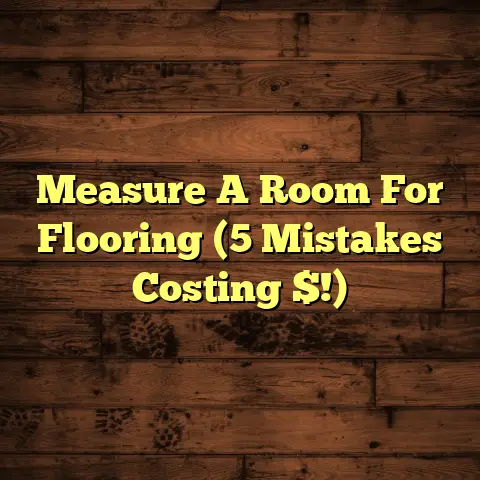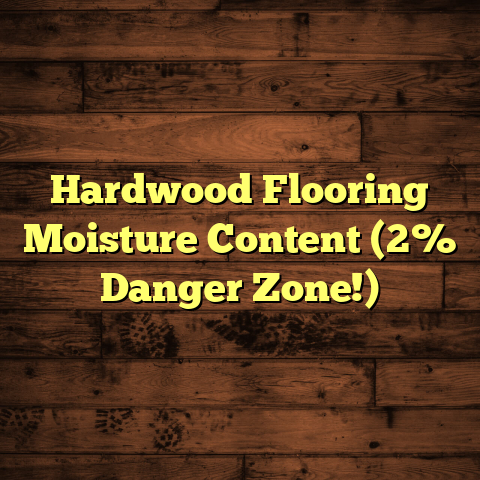Laminate Floor Adhesives: Guide (3 Glue Types)
Ever laid down a laminate floor, only to find it bubbling or shifting a few months later?
I’ve seen it happen way too often, and more often than not, it boils down to one simple mistake:
Assuming all adhesives are created equal.
Trust me, they’re not!
Choosing the right adhesive for your laminate floor is as crucial as picking the right planks.
It impacts everything from installation ease to the floor’s long-term durability and look.
In this guide, I’m going to walk you through the three main types of laminate floor adhesives, helping you make the best choice for your project.
Let’s dive in!
Section 1: Understanding
Laminate Flooring
First, let’s get on the same page about what laminate flooring actually is.
It’s not solid wood, but a multi-layered synthetic flooring product fused together through a lamination process.
Think of it like a high-tech sandwich, with each layer playing a vital role.
Wear Layer: This is the top, transparent layer that protects against scratches, stains, and fading.
It’s like the flooring’s bodyguard.Design Layer: This is where the magic happens!
It’s a high-resolution photographic image of wood, stone, or whatever look you’re going for.
It’s the face of your floor.Core Layer: This is the heart of the laminate, usually made of high-density fiberboard (HDF) or medium-density fiberboard (MDF).
It provides stability and resistance to impacts and moisture.Backing: The bottom layer that provides a moisture barrier and helps balance the floor.
It’s the floor’s anchor, preventing warping.
Why Choose Laminate?
I’ve installed countless floors over the years, and laminate remains a popular choice for good reasons:
Durability: Laminate is tough!
It can withstand heavy foot traffic, kids, and pets, making it ideal for busy households.Aesthetic Appeal: With advances in printing technology, laminate can mimic the look of real wood, stone, and tile incredibly well.
You can achieve a high-end look without breaking the bank.Cost-Effectiveness: Compared to hardwood or tile, laminate is significantly more affordable.
It’s a budget-friendly way to upgrade your home.
The Adhesive Connection
So, where does adhesive come into play?
Well, while many laminate floors now feature click-lock systems for easy “floating” installation, adhesives are still necessary in certain situations.
Think about:
Areas with high moisture: Bathrooms, laundry rooms, or basements.
Adhesive can help create a moisture-resistant barrier.-
Complex layouts: Intricate designs or areas with lots of cuts may require adhesive to secure the edges and prevent gapping.
-
Specific manufacturer recommendations: Some laminate manufacturers require adhesive for certain installations to maintain the warranty.
Ignoring these situations and skipping the adhesive can lead to:
-
Moisture damage: Warping, swelling, and mold growth.
-
Gapping and shifting: An unsightly and potentially hazardous floor.
-
Voided warranty: A costly mistake!
That’s why understanding your adhesive options is so important.
Section 2: Types of Laminate
Floor Adhesives
Alright, let’s get down to the nitty-gritty and explore the three main types of adhesives you’ll encounter for laminate flooring:
- Water-Based Adhesives
- Solvent-Based Adhesives
- Pressure-Sensitive Adhesives
1. Water-Based Adhesives
What are they?
Water-based adhesives, as the name suggests, use water as a solvent or carrier for the adhesive components.
They’re typically made from synthetic polymers like acrylics or vinyl acetate.
Advantages:
Low VOC Emissions: Volatile Organic Compounds (VOCs) are chemicals that evaporate at room temperature and can be harmful to your health.
Water-based adhesives have very low VOC emissions, making them a healthier and more eco-friendly choice.
I always recommend these for homes with children, pets, or allergy sufferers.Easy Cleanup: Spills and splatters are easily cleaned up with water while the adhesive is still wet.
This makes the installation process less messy and stressful.
Disadvantages:
Drying Times: Water-based adhesives generally have longer drying times compared to solvent-based options.
This means you’ll need to wait longer before walking on the floor.Moisture Sensitivity: While they’re better than nothing, water-based adhesives can be susceptible to moisture damage if exposed to excessive humidity or water.
They’re not the best choice for areas that are constantly damp.
2. Solvent-Based Adhesives
What are they?
Solvent-based adhesives use chemical solvents to dissolve and carry the adhesive components.
They often contain stronger polymers than water-based adhesives, resulting in a more durable bond.
Advantages:
-
Strong Bond Strength: Solvent-based adhesives provide a very strong and durable bond, making them ideal for high-traffic areas or installations where extra security is needed.
-
Water Resistance: They offer better water resistance compared to water-based adhesives, making them suitable for areas with occasional moisture exposure.
Disadvantages:
Odor and VOCs: Solvent-based adhesives have a strong odor and high VOC emissions.
Proper ventilation is essential during application, and you should always wear a respirator.-
Longer Drying Times: Similar to water-based adhesives, solvent-based options can have longer drying times.
3. Pressure-Sensitive Adhesives (PSAs)
What are they?
Pressure-sensitive adhesives (PSAs) are a unique type of adhesive that forms a bond when pressure is applied.
They typically come in the form of tapes or films and are pre-applied to the laminate planks or underlayment.
Advantages:
Ease of Use: PSAs are incredibly easy to use.
Simply peel off the backing and press the laminate plank into place.-
Quick Application: The application process is much faster compared to liquid adhesives, saving you time and effort.
Disadvantages:
-
Limited Strength: PSAs generally don’t provide the same level of bond strength as water-based or solvent-based adhesives.
-
Potential for Reactivation: In certain conditions (e.g., high temperatures), the adhesive can reactivate, causing the planks to shift or lose adhesion.
Specific Laminate Types: PSAs are not suitable for all types of laminate flooring.
Always check the manufacturer’s recommendations before using them.
Section 3: Choosing the Right
Adhesive for Your Project
Okay, now that you know the different types of adhesives, how do you choose the right one for your specific laminate flooring project?
Here are some key criteria to consider:
Type of Laminate Flooring:
- Thickness: Thicker laminate flooring may require a stronger adhesive.
- Manufacturer Recommendations:
Always follow the manufacturer’s
guidelines for adhesive selection.
This is crucial for maintaining your warranty.
Installation Environment:
- Humidity Levels: In areas with high humidity, choose a moisture-resistant adhesive.
- Subfloor Type: The subfloor
material (e.g., concrete, wood)
can affect adhesive performance.
Some adhesives are specifically formulated for certain subfloor types.
-
Desired Longevity and Performance:
- High-Traffic Areas: For areas with heavy foot traffic, opt for a strong and durable adhesive.
- Warranty Requirements: Make sure the adhesive you choose meets the manufacturer’s warranty requirements.
Here’s a quick cheat sheet to help you decide:
Example Scenarios:
Scenario 1: You’re installing laminate flooring in your living room, which has moderate foot traffic and a concrete subfloor.
You have kids and pets, so you’re concerned about VOC emissions.- Recommendation: A water-based adhesive specifically formulated for concrete subfloors would be a good choice.
Scenario 2: You’re installing laminate flooring in a commercial space with heavy foot traffic and a plywood subfloor.
You need a very strong and durable bond.- Recommendation: A solvent-based adhesive would be the best option, but make sure to provide adequate ventilation during installation.
Scenario 3: You’re installing laminate flooring in a small bathroom with a click-lock system.
You just want to secure the edges and prevent gapping.- Recommendation: A pressure- sensitive adhesive tape could be sufficient, but make sure it’s rated for moisture resistance.
Section 4: Application Techniques
for Each Adhesive Type
Alright, you’ve chosen your adhesive.
Now, let’s talk about how to use it correctly!
Proper application is just as important as choosing the right adhesive.
Here’s a step-by-step guide for each type:
1. Water-Based Adhesives
-
Surface Preparation:
- Ensure the subfloor is clean, dry, and level.
- Remove any debris, dust, or old adhesive residue.
- You may need to prime the subfloor to improve adhesion.
-
Adhesive Application:
- Use a notched trowel to apply the adhesive evenly to the subfloor.
- Follow the manufacturer’s recommendations for trowel size and spread rate.
- Work in small sections to prevent the adhesive from drying out.
-
Laminate Placement:
- Carefully place the laminate planks onto the adhesive, ensuring proper alignment.
- Press down firmly to ensure good contact with the adhesive.
- Use a rubber mallet to gently tap the planks into place.
Tips for a Strong Bond:
- Don’t apply too much adhesive.
A thin, even layer is better than a thick, gloppy one. - Follow the manufacturer’s recommended open time (the time between applying the adhesive and placing the laminate).
- Use a heavy roller to further ensure good contact between the laminate and the adhesive.
- Don’t apply too much adhesive.
2. Solvent-Based Adhesives
-
Preparation:
- Follow the same surface preparation steps as with water-based adhesives.
- Ventilation is crucial! Open windows and doors, and use a fan to circulate air.
- Wear a respirator to protect yourself from harmful fumes.
-
Adhesive Application:
- Apply the adhesive using a notched trowel, following the manufacturer’s recommendations for trowel size and spread rate.
- Work in small sections to prevent the adhesive from drying out.
-
Laminate Installation:
- Carefully place the laminate planks onto the adhesive, ensuring proper alignment.
- Press down firmly to ensure good contact with the adhesive.
- Use a rubber mallet to gently tap the planks into place.
Important Considerations:
- Solvent-based adhesives are highly
flammable.
Keep away from open flames or sparks. - Dispose of used adhesive and contaminated materials properly, following local regulations.
- Solvent-based adhesives are highly
flammable.
3. Pressure-Sensitive Adhesives
-
Quick Application:
- Ensure the subfloor is clean, dry, and level.
- Peel off the backing from the PSA tape or film.
- Carefully align the laminate plank and press it firmly onto the subfloor.
-
Handling Tips:
- Avoid touching the adhesive surface with your fingers.
- Use a roller to apply even pressure and ensure good adhesion.
- Work in small sections to prevent the adhesive from drying out (if it’s not pre-applied).
-
Alignment is Key:
- Because PSAs offer less forgiveness than liquid adhesives, careful alignment is crucial.
- Double-check the position of each plank before pressing it down.
Section 5: Common Challenges and
Solutions
Even with the best planning and application techniques, you might encounter some challenges along the way.
Here are some common issues and how to address them:
-
Issues with Adhesion:
- Weak Bond:
- Cause: Insufficient adhesive, contaminated subfloor, improper application.
- Solution: Reapply adhesive, clean the subfloor thoroughly, use the correct trowel size.
- Bubbling:
- Cause: Trapped air, excessive adhesive, uneven subfloor.
- Solution: Use a heavy roller to remove air pockets, apply less adhesive, level the subfloor.
- Weak Bond:
-
Environmental Considerations:
- Temperature:
- Challenge: Extreme temperatures can affect adhesive performance.
- Solution: Follow the manufacturer’s recommended temperature range for application.
- Humidity:
- Challenge: High humidity can slow down drying times and affect adhesion.
- Solution: Use a dehumidifier to control humidity levels, choose a moisture-resistant adhesive.
- Temperature:
Cleanup and Maintenance:
- Adhesive Residue:
- Challenge: Sticky residue on the surface of the laminate.
- Solution: Clean with a damp
cloth and a mild detergent.
For stubborn residue, use a solvent recommended by the adhesive manufacturer.
- Preventative Measures:
- Challenge: Preventing future adhesion problems.
- Solution: Use floor mats in high-traffic areas, clean spills promptly, and maintain consistent temperature and humidity levels.
- Adhesive Residue:
Section 6: Conclusion
We’ve covered a lot of ground in this guide, from understanding the basics of laminate flooring to choosing the right adhesive and applying it correctly.
The key takeaway is this: choosing the right laminate floor adhesive is not an afterthought; it’s a critical step in ensuring a successful and long-lasting installation.
By understanding the different types of adhesives, considering your specific project requirements, and following proper application techniques, you can avoid common pitfalls and achieve beautiful, durable floors that you’ll enjoy for years to come.
So, go forth and conquer your laminate flooring project with confidence!
And remember, if you ever have any doubts, don’t hesitate to consult with a professional flooring contractor.
Happy flooring!





